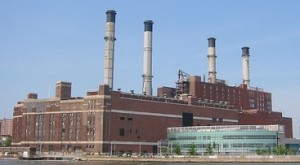
Coal burning power plants, like this New York City veteran, are fast becoming industrial dinosaurs because they do more harm than good. (Photo by futureatlas.com)
Last week, the East Kentucky Power Cooperative abandoned plans to build two coal-burning power plants in Clark County. This major setback for Big Coal in the heart of Big-Coal country, comes just a year after Ohio’s American Municipal Power gave up its attempt to build a coal fired electric plant on the Ohio River near Cleveland. And according to a Sierra Club tally, it brings the number of coal-fired generating plants planned, announced and then abandoned in recent years to over 100.
What accounts for all these black eyes for clean coal? Relentless public activism based on a slowly rising tide of research documenting the awesome costs of unrestrained fossil-fuel burning. Despite being chronically underfunded compared to the think tanks owned and operated by the coal industry, and despite constant and of course well-funded efforts to debunk any studies documenting the actual results of coal burning, various exercises in straightforward research and logic have recently quenched coal’s fire. For example:
- In Kentucky, the coal industry that contributes $528 million in annual revenues to the state (Yay!) costs the state $643 million a year in expenditures. (What?) — The Mountain Association for Community Economic Development.
- In Kentucky, investing in weatherization of homes and businesses, along with small-scale hydro- and wind-power projects, would generate more economic activity and create more jobs over a wider area and longer time span that the coal plant project, while meeting the area’s electricity demands without the mercury and CO2 pollution. — The Ochs Center for Metropolitan Studies.
We’ve known such things for years, of course, but in the absence of a budget to buy TV commercials on the Sunday talk shows the information just lies around, with the tire marks of the Big Coal machine all over it. But in Kentucky this year, and Ohio last year, a muscular alliance of local, regional and national public-interest groups organized, protested, filed lawsuits and wrote op-ed pieces with such energy and persistence that Big Coal lost several games at home.
Good to know it can still happen.
In Kentucky, the power company that wanted to build the coal burner agreed last week not only to drop it, but to invest time and money in a collaboration with its erstwhile enemies to promote and fund weatherization and sustainable-energy projects.
Weatherization is the ugly duckling of the environmental movement. Although it has no sex appeal, when it comes to conservation, reducing pollution, and taking the wind out of the sails of Big Coal, nothing yields a bigger bang for the buck than caulking and weatherstripping old houses.
The other saving grace that may emerge from such victories for semi-sustainability as in Kentucky last week is a heightened appreciation of the benefits of reducing the scale of energy projects. Small hydro projects are less damaging than huge ones, and wind farms are less polluting and more renewable than fossil fuel plants. (Although not entirely so; one still has to manufacture, transport and eventually replace the huge turbines, and build a grid to get the power from the wind farm to the city house. Renewable is not sustainable if it’s industriial.)
As heartening as the Kentucky victory is, it would be good to see some muscular activism behind a logical extension of the smaller-scale argument, one that says to every home and building owner: make your energy where you use it. Now we’re talking about getting to a place where sustainable living is at least possible.